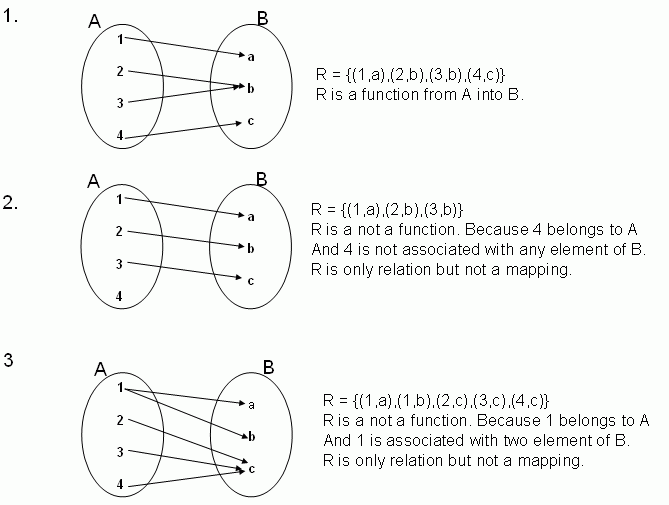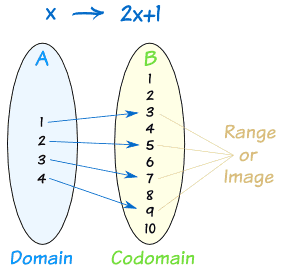1. "Understand that a function from one set (called the domain) to another set (called the range) assigns to each element of the domain exactly one element of the range. If f is a function and x is an element of its domain, then f(x) denotes the output of f corresponding to the input x. The graph of f is the graph of the equation y = f(x)." (Source 1)
 |
| (Source 2) |
 |
| (Source 3) |
f(n-1) for n ≥ 1." (Source 1)
An objective for each of these standards are:
1. Students will be able to understand the concept of a function by explaining the definition of a function and determining if f is a function.
2. Students will be able to solve functions to evaluate functions domains and outputs with context.
3. Students will be able to understand functions include some sequences by determining and explaining if sequences are functions.
For this unit on functions, if I were to have four students at different stages in their English Language Development, I would tailor the objectives above to meet their learning needs and help them succeed in the classroom. For example, let's say that I had one student at the beginning level, one student at the early intermediate level, one student at the intermediate level, and another student at the early advanced level. The reason that I chose these levels is because the earlier levels of your English Language Learner takes more care and modifications to help the child benefit from the classroom.
 |
| (Source 6) |
1. "Beginning - From Total Physical Response (TPR) to simple sentences.
2. Early Intermediate - From phrases to complete sentences.
3. Intermediate - From complex sentences to paragraphs.
4. Early Advanced - Content language support through higher order thinking and speaking.
5. Advanced - From oral to written language proficiency
6. Reclassified - Many students are reclassified at the Early Advanced Level and will need continued support to access and develop a strong base of academic language." (Source 4)
 |
| (Source 5) |
 |
| (Source 9) |
 |
| (Source 10) |
For the student at the intermediate level, I would provide a sufficient amount of time for the student to respond because at this stage the student may know the words, but it may take them time to translate it in their head before responding. (Source 4) I would also try and encourage the student to clarify the key concepts in their primary language. (Source 4) This allows the student to think on a deeper level in their first language so their understanding in their second language also advances. I would increase the level of difficulty in their responses by giving them more depth in their sentence starters. For example, "We have concluded that...", "My thoughts are that...", "Perhaps it would work if...", etc. With the new change in the standards to Common Core, it is important that students are able to express mathematical concepts in writing. In order to be successful at this the student must be able to explain, analyze, and compare, which they are starting to be more effective at doing at this level.
 |
| (Source 11) |
 |
| (Source 12) |
 |
| (Source 13) |
1. Common Core State Standards Initiative | Home. Mathematics Standards . Retrieved February 13, 2014, from http://www.corestandards.org/assets/CCSSI_Math%20Standards.pdf
2. http://kwiznet.com/px/homes/i/Grade9/Relations/Relations_And_Functions.gif
3. http://www.mathsisfun.com/sets/images/domain-range-codomain.gif
4.Irma Bravo, L. (2009). California Levels of English Language Development (CELD). Stanislaus County Office of Education.
5. http://assets.pearsonschool.com/asset_mgr/current/201035/language_proficiency_chart.jpg
6. http://www.wellingtoncssb.edu.on.ca/Programs/progstudents/English-Language-Learners-Program-ELL/PublishingImages/Support%20English%20Language%20Learners.png
7. (2005). Southern Utah University - Cedar City, Utah. Six Key Strategies for Teachers of English-Language Learners.Retrieved February 13, 2014, from http://suu.edu/ed/fso/resources/esl-six-key-strategies.pdf
8. All About Adolescent Literacy | AdLit.org. Double-Entry Journals | Classroom Strategies | AdLit.org. Retrieved February 13, 2014, from http://www.adlit.org/strategies/22091/
9. http://en.islcollective.com/wuploads/preview/small_islcollective_worksheets_elementary_a1_preintermediate_a2_elementary__oard_game__maths_in_english_addition__easy_136864edb3f3b52ded7_51723957.jpg
10. https://blogger.googleusercontent.com/img/b/R29vZ2xl/AVvXsEid7r08d4y-Tbi29BTqo-JRO5Qn0fDibtM6RTcMmZnbpW7E9lEfYpWtMGeWtft5OBXI4ixO9RNwJeJ4nEwNA1VHFcFvHirn-L-8XLLB_1OVnjxcsWRKfa0idpdAk5Vyqa4CqXkXNd9F9bI/s1600/IMG_1406.JPG
11. http://www.scholastic.com/parents/sites/default/files/styles/featured_image/public/field_asset_image/6913/0650/7736/Girl_chalkboard_math.jpg?itok=MDuSNbMS
12. http://shrdocs.com/pars_docs/refs/9/8850/img5.jpg
13. http://whitney.org/image_columns/0032/5295/pd_3_500.jpg
2. http://kwiznet.com/px/homes/i/Grade9/Relations/Relations_And_Functions.gif
3. http://www.mathsisfun.com/sets/images/domain-range-codomain.gif
4.Irma Bravo, L. (2009). California Levels of English Language Development (CELD). Stanislaus County Office of Education.
5. http://assets.pearsonschool.com/asset_mgr/current/201035/language_proficiency_chart.jpg
6. http://www.wellingtoncssb.edu.on.ca/Programs/progstudents/English-Language-Learners-Program-ELL/PublishingImages/Support%20English%20Language%20Learners.png
7. (2005). Southern Utah University - Cedar City, Utah. Six Key Strategies for Teachers of English-Language Learners.Retrieved February 13, 2014, from http://suu.edu/ed/fso/resources/esl-six-key-strategies.pdf
8. All About Adolescent Literacy | AdLit.org. Double-Entry Journals | Classroom Strategies | AdLit.org. Retrieved February 13, 2014, from http://www.adlit.org/strategies/22091/
9. http://en.islcollective.com/wuploads/preview/small_islcollective_worksheets_elementary_a1_preintermediate_a2_elementary__oard_game__maths_in_english_addition__easy_136864edb3f3b52ded7_51723957.jpg
10. https://blogger.googleusercontent.com/img/b/R29vZ2xl/AVvXsEid7r08d4y-Tbi29BTqo-JRO5Qn0fDibtM6RTcMmZnbpW7E9lEfYpWtMGeWtft5OBXI4ixO9RNwJeJ4nEwNA1VHFcFvHirn-L-8XLLB_1OVnjxcsWRKfa0idpdAk5Vyqa4CqXkXNd9F9bI/s1600/IMG_1406.JPG
11. http://www.scholastic.com/parents/sites/default/files/styles/featured_image/public/field_asset_image/6913/0650/7736/Girl_chalkboard_math.jpg?itok=MDuSNbMS
12. http://shrdocs.com/pars_docs/refs/9/8850/img5.jpg
13. http://whitney.org/image_columns/0032/5295/pd_3_500.jpg
No comments:
Post a Comment